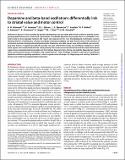| dc.contributor.author | Schwerdt, HN | |
| dc.contributor.author | Amemori, K | |
| dc.contributor.author | Gibson, DJ | |
| dc.contributor.author | Stanwicks, LL | |
| dc.contributor.author | Yoshida, T | |
| dc.contributor.author | Bichot, NP | |
| dc.contributor.author | Amemori, S | |
| dc.contributor.author | Desimone, R | |
| dc.contributor.author | Langer, R | |
| dc.contributor.author | Cima, MJ | |
| dc.contributor.author | Graybiel, AM | |
| dc.date.accessioned | 2021-10-27T20:23:12Z | |
| dc.date.available | 2021-10-27T20:23:12Z | |
| dc.date.issued | 2020 | |
| dc.identifier.uri | https://hdl.handle.net/1721.1/135379 | |
| dc.description.abstract | Copyright © 2020 The Authors, some rights reserved. Parkinson's disease is characterized by decreased dopamine and increased beta-band oscillatory activity accompanying debilitating motor and mood impairments. Coordinate dopamine-beta opposition is considered a normative rule for basal ganglia function. We report a breakdown of this rule. We developed multimodal systems allowing the first simultaneous, chronic recordings of dopamine release and beta-band activity in the striatum of nonhuman primates during behavioral performance. Dopamine and beta signals were anticorrelated over secondslong time frames, in agreement with the posited rule, but at finer time scales, we identified conditions in which these signals were modulated with the same polarity. These measurements demonstrated that task-elicited beta suppressions preceded dopamine peaks and that relative dopamine-beta timing and polarity depended on reward value, performance history, movement, and striatal domain. These findings establish a new view of coordinate dopamine and beta signaling operations, critical to guide novel strategies for diagnosing and treating Parkinson's disease and related neurodegenerative disorders. | |
| dc.language.iso | en | |
| dc.publisher | American Association for the Advancement of Science (AAAS) | |
| dc.relation.isversionof | 10.1126/SCIADV.ABB9226 | |
| dc.rights | Creative Commons Attribution NonCommercial License 4.0 | |
| dc.rights.uri | https://creativecommons.org/licenses/by-nc/4.0/ | |
| dc.source | Science Advances | |
| dc.title | Dopamine and beta-band oscillations differentially link to striatal value and motor control | |
| dc.type | Article | |
| dc.contributor.department | McGovern Institute for Brain Research at MIT | |
| dc.contributor.department | Massachusetts Institute of Technology. Department of Brain and Cognitive Sciences | |
| dc.contributor.department | Koch Institute for Integrative Cancer Research at MIT | |
| dc.contributor.department | Massachusetts Institute of Technology. Department of Chemical Engineering | |
| dc.contributor.department | Massachusetts Institute of Technology. Department of Materials Science and Engineering | |
| dc.relation.journal | Science Advances | |
| dc.eprint.version | Final published version | |
| dc.type.uri | http://purl.org/eprint/type/JournalArticle | |
| eprint.status | http://purl.org/eprint/status/PeerReviewed | |
| dc.date.updated | 2021-03-24T12:34:55Z | |
| dspace.orderedauthors | Schwerdt, HN; Amemori, K; Gibson, DJ; Stanwicks, LL; Yoshida, T; Bichot, NP; Amemori, S; Desimone, R; Langer, R; Cima, MJ; Graybiel, AM | |
| dspace.date.submission | 2021-03-24T12:34:57Z | |
| mit.journal.volume | 6 | |
| mit.journal.issue | 39 | |
| mit.license | PUBLISHER_CC | |
| mit.metadata.status | Authority Work and Publication Information Needed | |
